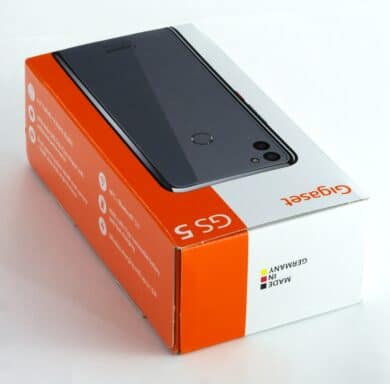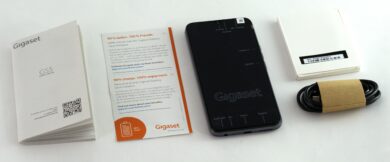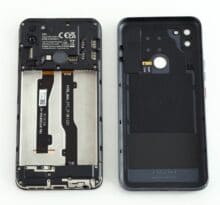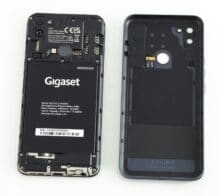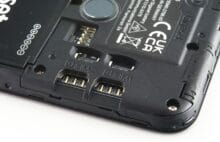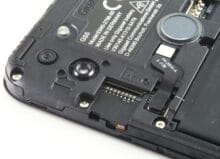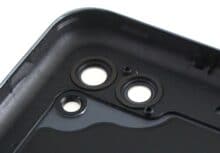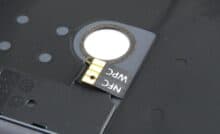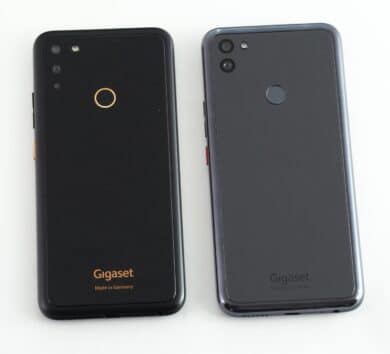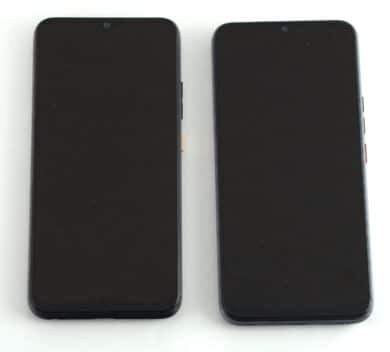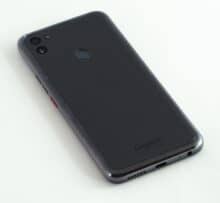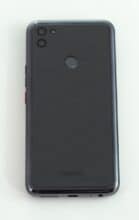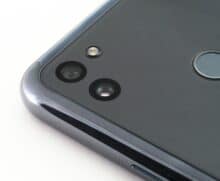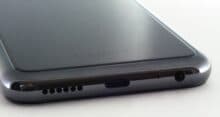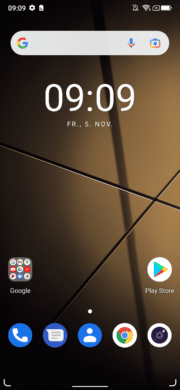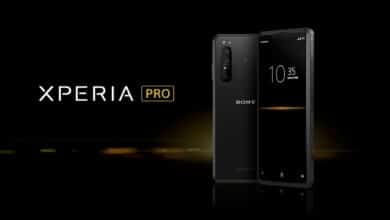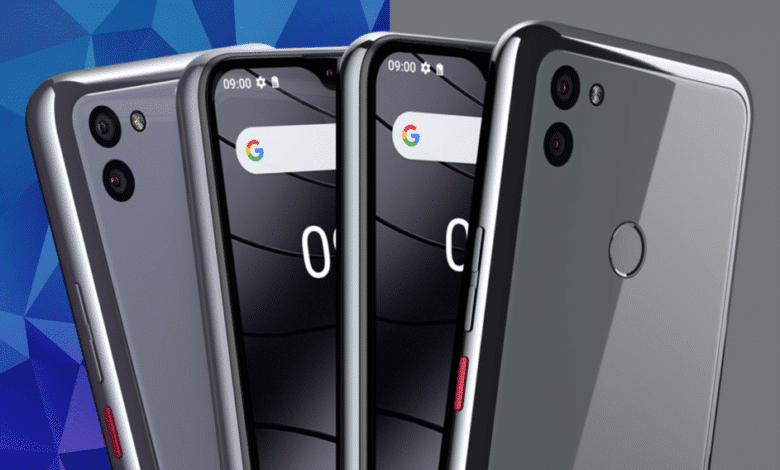
One year after Gigaset introduced a new series with the two smartphones GS3 and GS4, another model is added with the GS5. Although it is similar to the previous top model GS4 in some aspects, the technology of the new model has been significantly revised. For example, the Mediatek Helio G85 is a more modern SoC, the hard drive is doubled to 128 GB, Android 11 is guaranteed to be updated, and the camera unit is supposedly significantly improved. Beyond that, the GS5 is again advertised with wireless charging, a final manufacturing in Germany, and a replaceable battery. Whether the overall package is thus sufficient to justify the price of 300 Euros [current: € 275.00 *] called at launch, and whether we would recommend the Gigaset GS5, we will clarify in the following review.
Specifications
| Operating system: | Android 11 (Android 12 announced) |
| Display: | 2340 x 1080 pixels, 6.3″, 450 cd/m² |
| Rear camera: | Main camera: 48 MP F1.8 / F2.2 Wide Angle/Macro: 8 MP Video: 2560 x 1440 |
| Camera (front): | 16 MP F2.0 |
| Interfaces: | USB-C 2.0, 3.5mm jack, WLAN 802.11a/b/g/n/ac, Bluetooth 5.0, NFC, 4G |
| Sensors: | Fingerprint sensor, position sensor, proximity sensor, brightness sensor, e-compass, gyroscope |
| Notification LED: | Present |
| SoC: | Mediatek Helio G85 |
| CPU: | 2x 2.00 GHz Cortex-A75 + 6x 1.80 GHz Cortex-A55 |
| GPU: | Mali-G52 MP2 |
| RAM: | 4 GB |
| Memory: | 128 GB |
| Battery: | 4,500 mAh, wireless charging |
| Dimensions: | 157.5 x 75 x 10.4 mm |
| Weight: | 210 g |
| Inserts: | 2x nano-SIM + 1x microSD |
| Variants: | Dark Titanium Gray, Light Purple |
| Price: | 300 €, current: € 275.00 * |
Scope of delivery
In terms of packaging design, Gigaset remains true to its previous principles: the GS5 also arrives in a white-orange cardboard box. Besides the smartphone itself, the box contains the usual paperwork as well as the separately packaged battery and a 1.0 meter long USB-C charging cable. However, a charger and a SIM opener are not included. At least the latter is not even necessary for the device, since the smartphone’s entire casing can be removed without tools.
Design & Workmanship
The GS5’s format is very similar to that of the GS4: the dimensions are almost identical, but the GS5 is a few millimeters longer and thicker, as well as a few grams heavier. This is probably also on account of the slightly larger battery with 4,500 mAh, which already weighs 75g alone.
The layout of the ports has also remained the same on both new smartphones. Once again, the fingerprint sensor is on the back and the jack on the bottom. Visually, the new smartphone has changed a bit more. The GS5 and GS4 are very similar from the front, but the back of the new model has been redesigned. Instead of the black-gold look of the GS4, the GS5 comes with a dark gray case. The conspicuous decorations of the predecessor are thus omitted. The only thing that remains is the colored power button, which is red, just like in the GS3.
The new look makes the GS5 a bit more inconspicuous than the Gigaset GS4, but at least in our eyes, the predecessor was still nicer. The golden accent elements gave the smartphone a very high-end impression visually. However, it probably does not matter in practice anyway, because the smartphone is likely to end up in a case most of the time anyway.
With regard to build quality, the GS5 could convince us: the smartphone is stable and torsion-resistant, we could not discover any flaws or conspicuous features. Furthermore, the mechanism for removing the back is also successful: It has a small indentation on the lower right corner. The cover can simply be removed via this and you have direct access to the SIM cards, the microSD slot and the battery.
Software, performance & battery life
As usual for Gigaset, the GS5 also relies on standard Android, with version 11 being used ex-factory. The company has also commendably already announced an update to Android 12 for the future.
Gigaset only provides the standard Android configuration in terms of installed apps. Annoying third-party software that cannot be uninstalled is omitted. Thus, only just over 18 GB of the total storage is used ex-factory, leaving around 110 GB for the user.
To run the installed programs, Gigaset GS5 relies on a Mediatek Helio G85 from TSMC’s 12 nm production. The CPU consists of two Cortex-A75 cores with 2.00 GHz and six Cortex-A55 cores with 1.8 GHz. The installed GPU is a Mali-G52 MP2 and the working memory is 4 GB.
In practice, the SoC delivers the performance expected from it: Even under permanent load, the performance is consistent and sufficient to operate the smartphone completely smoothly and to switch between apps. Apart from elaborate 3D games, the performance should never be a problem here. However, with regard to the installed memory, a slightly higher random write speed certainly would not have hurt.
| Benchmark | Score |
| 3DMark Sling Shot | 1884 |
| 3DMark Sling Shot Extreme | 1414 |
| 3DMark Wild Life | 722 |
| 3DMark Wild Life Extreme | 183 |
| PCMark 10, Work 3.0 | 8672 |
| PCMark 10, Storage 2.0 | 6619 |
| PCMark 10, Seq Read | 293.64 MB/s |
| PCMark 10, Seq Write | 213.82 MB/s |
| PCMark 10, Random Read | 21.73 MB/s |
| PCMark 10, Random Write | 7.45 MB/s |
| Geekbench 5, SingleCore | 353 |
| Geekbench 5, MultiCore | 1297 |
| Geekbench 5, OpenCL | 1158 |
| Geekbench 5, Vulkan | 1273 |
On the other hand, there is considerably less movement compared to the predecessor in terms of battery life. The GS5 lasted 8:04 hours at maximum brightness in the PCMark 10 Battery Test 3.0. Our model lasted 10:17 hours at half brightness and 13:14 hours at minimum brightness. Thus, the smartphone can cope with normal everyday use without problems, but there are also models with much longer breath.
Display, camera & multimedia
Of course, not only the performance and the software are important for a smartphone, but especially the multimedia capabilities. Here, there are partly significant improvements with the GS5, but also a small damper.
Very little has changed in the display: Size, pixel count and specified brightness are identical to the GS4, and the displays are also similar in a direct comparison. Thus, the verdict remains the same: The color reproduction is good and the backlight is bright enough for normal use, even though bright summer days could be a problem.
The Gigaset GS5 also performs solidly in terms of telephony features: The phone speaker is good enough for intelligible communication, and we also liked the quality of the built-in microphone. Voices are not recorded with a perfectly neutral sound, but they are well understandable and free of noise.
We also like the DAC behind the jack socket. Unfortunately, the smartphone takes a step backwards in terms of the playback speaker: It lacks bass and sounds sometimes sound distorted. It is still sufficient as an emergency solution, but we would have wished for something more here.
The Gigaset GS5 has made a significant quality leap in the camera. The GS5 only has two cameras instead of three, but they are superior to Gigaset’s previous solutions in every respect. The main camera with its up to 48 MP delivers color-coordinated and sufficiently low-noise results to enable good souvenir or social media photos. We would like to point out that our test shots with fine blades of grass during the day and strong contrasts at night pose challenges for the cameras and should emphasize the weaknesses. Of course, a better result is always possible in such scenarios, but the offered quality should be more than sufficient for most users. This also applies to the night mode and the selfie camera.
Conclusion
Gigaset expands its own range upwards with the GS5. The GS5, which costs 300 Euros [current: € 275.00 *] at launch, often looks like a (significantly) pimped GS4. Already known core points like the unchanged Android, the exchangeable battery, the wireless charging function and the final production in Germany have remained the same. As in the predecessor, there is nothing to complain about in terms of build quality.
The smartphone’s other features have changed more: The storage of 128 GB is bigger and the installed CPU is much more powerful. You can get a bit more performance in this price range, but the GS5 can still be used smoothly and fluently.
The second big change is the GS5’s new camera, and Gigaset could convince us here. While the camera of the GS4 was only moderately good, the sensors of the GS5 are quite capable of taking good pictures. This is not an absolutely unique selling point for the price range, but the GS5 has its special features elsewhere. Of course, we also have to keep in mind that we evaluate the GS5 at the RRP – the actual price might be lower in a few weeks.
The bottom line is that what we said about the GS4 a year ago still applies to the GS5: The device is mainly made special by the special features like the standard Android, the exchangeable battery and wireless charging. If you like these features, you should take a closer look at the GS5, because the other usual demands are satisfactorily covered. For the hopefully planned GS6, we would only wish for better speakers and a thinner case.
Gigaset GS5
Workmanship
Hardware
Multimedia
Performance
Battery
Value for money
86/100
A great smartphone that stands out from the crowd with a replaceable battery and wireless charging.
